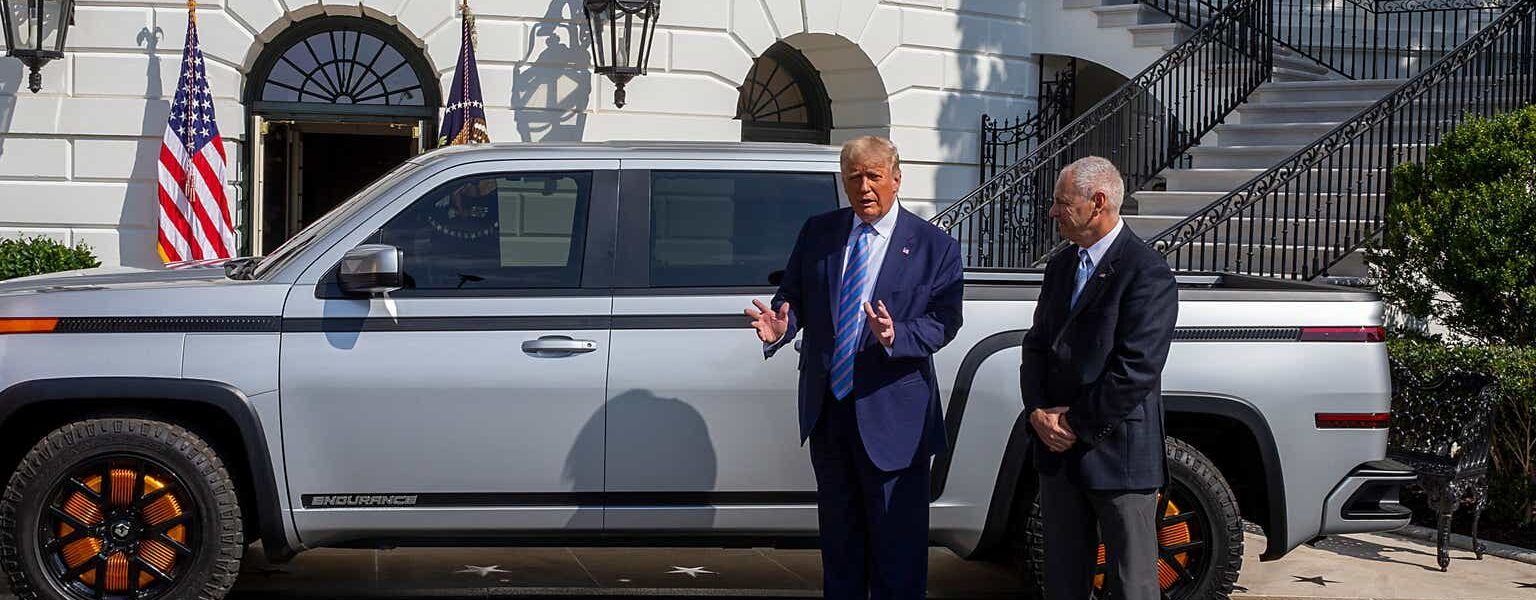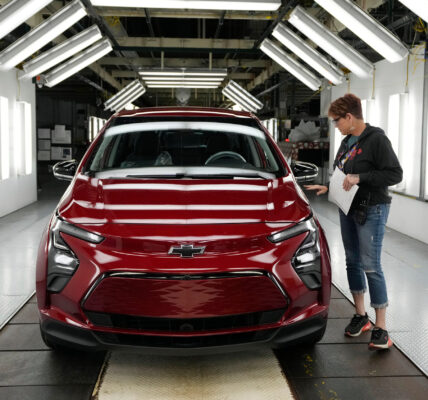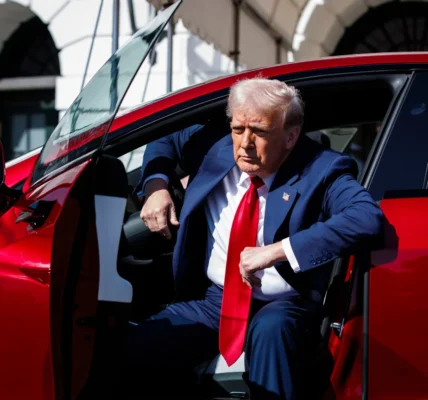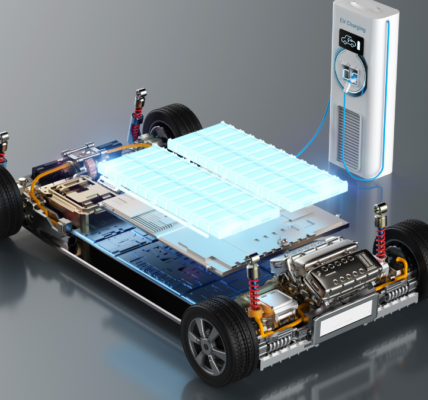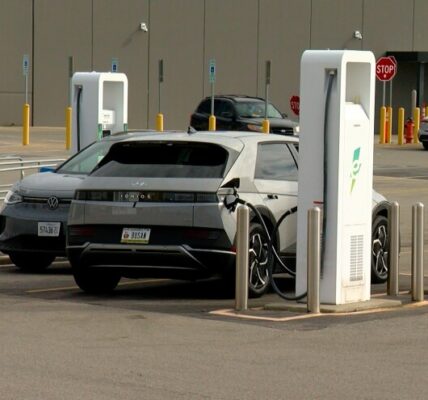The Bitter Conclusion of Trump’s Failed Flirtation With Electric Vehicles
“Well, ladies and gentlemen, this is incredible,” President Trump boasted in front of a gleaming white pickup parked on the South Lawn driveway in late September 2020. At a glance, the truck kind of resembled a Toyota Tacoma or a Ford F-150. Its unusual face gave it away—that, and the enormous copper-colored discs inside its wheels.
The truck was an electric Lordstown Endurance, built by start-up Lordstown Motors at a long-troubled former General Motors plant near Youngstown, Ohio. A year after GM closed that factory and laid off its workers, Trump, ever the salesman, was trying to sell a comeback story for Midwestern manufacturing driven by cutting-edge electric vehicle technology.
“Until this, nobody has actually done it, having the motors in each wheel—having motors in each wheel,” Trump repeated, exuding all the confidence of someone who learned how the truck worked five minutes before the cameras started rolling. “And they’re very well coordinated, and you can work them individually or whatever is necessary, by computer.”
It is highly unlikely that Trump considers himself a great aficionado of wheel hub motors, the signature technology used in Lordstown’s truck. What mattered on that morning was that, at least in Trump’s mind, he was bringing thousands of jobs back to a crucial swing state just weeks before the election he’d ultimately lose.
But last week, Lordstown Motors announced it had filed for bankruptcy, less than three years after Trump’s truck show on the White House lawn. The company is embroiled in a bitter lawsuit with its technical partner and current factory owner, Taiwanese iPhone manufacturing giant Foxconn. Only a handful of trucks seem to have been delivered to customers. By May, Lordstown Motors was on its third round of recalls, even after coming off a lengthy production halt to fix quality issues. Headlines lately have depicted the automaker as a startup on life support, not a lifeline for a region that needed it. The whole thing feels incredibly cynical and hollow in hindsight.
These days, Trump sings a different tune, now that promoting E.V.s is no longer politically convenient for him. Last week, he spent time in Michigan stoking fears that E.V.s—which generally require less labor and parts to build than conventional cars—will decimate manufacturing job. Meanwhile, even the reliably democratic United Auto Workers union is holding off on endorsing President Biden again, saying it wants more guarantees that American auto jobs and wages won’t be lost to the electric transition. The push and pull between environmentally friendly cars and labor could end up a contentious issue in the 2024 presidential election and beyond. The question is whether workers in Ohio will forget the time Trump used the promise of an electric future to further his own political gains—while leaving his own constituents in the lurch.
To be fair, Trump’s hype-man act for Lordstown Motors in 2020 is hardly the first time a president has backed an electric automotive concern that ended poorly. A decade ago, the Obama administration spent a lot of money on “green loans” to automakers that ultimately failed to generate the jobs promised—and, in some cases, weren’t all that green. (The initiative did provide Tesla a needed assist at the time; now it’s the world’s largest maker of battery E.V.s.)
Most E.V. start-ups are not going to become the next Tesla, but it was clear almost from the company’s inception that Lordstown Motors was really not going to become the next Tesla. It was always dogged by management shuffles, unfulfilled promises, and the brutal challenges of making a competitive E.V. Lordstown Motors maybe only existed as a perfect replacement for GM’s withdrawn Ohio investment in Trump’s mind.
What used to be called GM Lordstown Assembly was born in 1966 in Ohio’s Mahoning Valley and died in 2019. It began life as a state-of-the-art factory for GM’s popular full-size sedans like the Chevrolet Impala, was the site of a famous wildcat strike in 1972, and then saw its workforce dwindle over decades of American auto industry bloat, mismanagement, and decline. To the workers’ credit, Lordstown Assembly’s final car, the compact Chevrolet Cruze, was a very good one—but it was no match for years of brutal small-car competition from Japan and Korea or the rush of buyers to trucks and SUVs.
By the end of its life as a GM factory, Lordstown Assembly employed about 1,500 workers, a far cry from its peak of nearly 20,000 in the 1990s. The plant’s decline, coupled with the collapse of the local steel industry a few decades before, helped the Mahoning Valley fall into hard times. Populations dipped, poverty rose, and hopes for the future dwindled. By the time Trump took office, what was once a thriving community with high homeownership had become another poster child for Rust Belt decline.
So when the factory in Lordstown was shuttered amid a GM reorganization in the late 2010s, it was logical to wonder: Why not just use the plant for something else? Post-bailout GM, though profitable, had been investing heavily in China and Mexico for years. But in Ohio, the automaker calculated it was too expensive to retool the old plant to build another vehicle. Besides, it needed to slash costs to get ready for the E.V. era. “At the end of the day, [CEO] Mary Barra is doing what’s best for GM,” an analyst said at the time..
When the Lordstown plant closed, Trump decided that this time, what was good for GM was not good for America. He had spent years promising Ohio the manufacturing jobs were coming back: “Don’t move. Don’t sell your house,” he famously told Ohio voters after taking office. Clearly, GM taking more business out of a region he’d bragged he’d revive could not stand, so he spent months targeting Barra personally on Twitter.
In May 2019, Trump tweeted a solution of sorts: GM would sell its “beautiful” Lordstown plant to a manufacturing company called Workhorse Group to build electric trucks. Jobs would be saved, cars were coming back to Ohio, and America was put First yet again. Unfortunately, the announcement was vastly premature—GM was only in early talks with Workhorse at the time. It ended up selling the factory to a new start-up called Lordstown Motors instead, with GM as an investor to make this political problem (hopefully) disappear.
Could a tiny, brand-new effort to make electric commercial pickup trucks really replace all those manufacturing jobs lost to GM’s downsizing? Steve Burns, Lordstown Motors’ first CEO, said in 2020 that he hoped to employ up to 5,000 people in the coming years. Yet from almost the beginning, Lordstown Motors was plagued with problems. The company went public in 2020, but by May of the following year, Burns was out. A short-seller firm said the former CEO’s claim of 100,000 preorders of the truck was bunk, inviting probes from the Justice Department and the Securities and Exchange Commission. Public financial filings indicated that the company didn’t have enough capital yet to start mass production.
In came Foxconn to purchase Lordstown’s factory, inject some badly needed capital, and start a partnership for a nascent contract E.V. manufacturing business. After all, if Foxconn could do that for smartphones, could it do the same for cars? But that effort ended in disaster too. In a lawsuit filed this month, Lordstown now accuses Foxconn of, essentially, slow-walking its promises and funding to starve out the company and take the factory and top talent for itself. (Foxconn didn’t respond to a request for comment, but the company told CNBC it found these claims “baseless”; a spokesperson for Lordstown directed The New Republic to a recent statement and the lawsuit filing.)
These issues weren’t helped by the fact that the Endurance itself was riddled with production problems. The vehicle was theoretically aimed at commercial work-truck buyers, but its value proposition became even more unclear as more electric trucks from real car companies like Ford and GM started entering the market. And commercial or not, it always seemed to lack the hype and engineering cachet of other E.V. newcomers. Its range of just 174 miles put it in the bottom tier of modern E.V.s, and critics balked at its $65,000 price tag. The savior of Ohio’s automotive sector just didn’t seem all that up to the job.
It’s unclear what might emerge from Lordstown Motors’ bankruptcy process and fight with Foxconn, but it certainly doesn’t feel like anything great. The jobs that Trump promised never materialized. Another start-up has plans to build an affordable E.V. at the now Foxconn-owned Lordstown plant, but that’s quite a ways off. And Foxconn’s own contract auto business is off to a rough start.
Whether the component parts of Lordstown Motors and Foxconn’s E.V. ambitions have any value remains to be seen. But the challenges around jobs and the rapidly transforming automotive industry aren’t going anywhere. Many of Trump’s recent claims about E.V.s, especially their range, are demonstrably false, but he’s right that the future auto business may require fewer jobs than it does now. The situation is setting up a global labor fight over E.V.s that we’ll see play out in Europe, Japan—and certainly in the United States.
How voters in automotive-sector states respond to this struggle will be interesting to see. Plenty of Trump supporters in Lordstown’s backyard have told reporters that they felt duped by his job claims in 2020. The bankruptcy of Lordstown Motors must only add to that sting. But despite the union brass’s past support for Biden, internal UAW polling shows that more than 30 percent of its members voted for Trump in 2016 and 2020.
In the short term, there’s yet another labor fight between the people of the Mahoning Valley and GM. Literally down the road from Lordstown Motors is the car giant’s new Ultium Cells “gigafactory,” a joint venture with South Korea’s LG to mass-produce the batteries for tomorrow’s E.V.s. Whether those will be good-paying manufacturing jobs—the kind GM’s Lordstown workers used to enjoy—hinges on the UAW’s upcoming contract negotiations. That’s when 1,100 workers in the Ultium plant will fight to be considered full GM employees with commensurate pay, rather than the joint venture employees they are now, making less money than they would at a local Waffle House.


